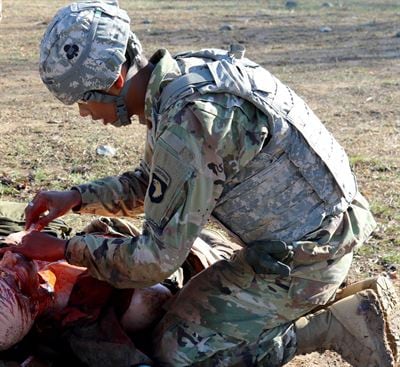When bullets are flying and a service member needs treatment, a combat medic can’t be worried about taking notes.
But knowing what happened and how a patient was treated helps their future treatment, and it can assist wounded warriors when claiming disability.
Researchers at Clemson University are working on a hands-free system for medics to document battlefield care and ensure troops receive the benefits they deserve.
Although in its early stages, the system includes a hands-free device that records audio and video. The plan is to have the audio automatically transcribed, separating words from battlefield noises, which would let doctors know how to properly care for the patient once they’re off the battlefield.
This information would become part of the service member’s permanent record, helping them prove they were injured in battle.
Through a two-year, $1.6 million Defense Department-funded pilot program, the researchers are developing the components that would enable this to happen.
Medics currently use a handheld mobile device to enter data, according to Loretta Schlachta-Fairchild with Army Medical Research and Materiel Command.
Existing technology doesn’t solve this problem for the military because even though recorders can separate noise and words in noisy settings like coffee shops, train stations and hospitals, it can’t drown out the kinds of sounds found on a battlefield, according to Kuang-Ching “K.C.” Wang, a professor of electrical and computer and engineering at Clemson.
“Once you get into this very complex, noisy situation, it’s very hard to have reliable performance,” he told Army Times.
Recorders that perform well in certain, identified settings rely on very targeted training of its algorithm that deals particularly for that environment, Wang said.
“We need data accumulated from the battlefield,” he said, adding that they can aggregate sounds and video from the battlefield and use it to train their algorithm.
Since they don’t have authentic battlefield noises at the moment, they’re gathering them from a simulation center at Palmetto Health, a health-care system in South Carolina that the researchers have partnered with.
The research team is trying to create environments similar to those found on a battlefield so their algorithm can learn which sounds to separate and which ones are important.
Wang said the team must tackle three different challenges:
- How to deal with the noise and build a noise model to identify and remove noise from the data.
- Once the algorithm recognizes all of the words, it needs to figure out the meaning of those words in the sentence.
- How to address the language because each one will have different characteristics the algorithm needs to recognize.
“Speech will be our first and foremost focus for the first year and a half,” Wang said. “Then as we enter the second year, we will also venture into video processing.”
The goal is to have medics wear a GoPro, or something similar, that saves the recording to a small device attached to them that goes with the patient.
Ron Gimbel, chair of the Department of Public Health Sciences at Clemson, said the team will present a performance report to the Defense Department in February, and they’ll receive feedback on their progress.
Gimbel, a retired Navy officer, said he will also be conducting focus groups in February to make sure the system is built in a useful way. The focus groups will include combat medics and emergency medical services crews.
“It will help us understand what information is the most critical, and how it should be structured,” he said.
Palmetto Health, who the team is working with, uses the same electronic health records system that the Defense Department is transitioning to, Gimbel said.
The team is using input from three emergency physicians at Palmetto Health, including one who works with tactical emergency medicine.
Charlsy is a Reporter and Engagement Manager for Military Times. Email her at cpanzino@militarytimes.com.




